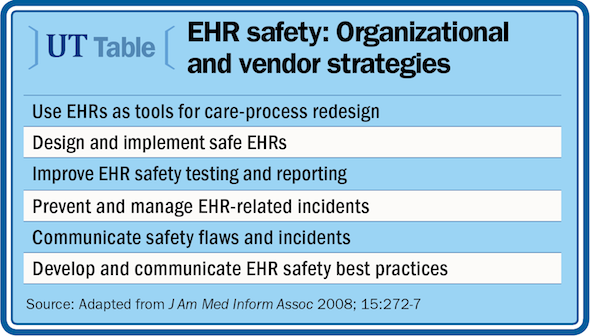Article
Could your EHR system put patients at risk?
In this article, Robert A. Dowling, MD, discusses what you need to know about EHRs and patient safety.

One of the most dominant conversations in urology practices today concerns the impact of adopting health information technology on providers, processes, and even profitability. Sometimes lost in the conversation is the impact of electronic health record adoption on the patient-the recipient of those care processes and care providers.
Related - EHR difficulty? Solution may lie within work flow
The HITECH Act set aside billions of dollars to incentivize the implementation and adoption of EHRs to improve data capture (Meaningful Use Stage 1), processes of care (Meaningful Use Stage 2), and clinical outcomes (Meaningful Use Stage 3). Many hospitals and physician practices have discovered, though, that the road is paved with imperfections, uncertainty, and unintended consequences-including those that can represent a safety concern in patient care. In this article, I will discuss what you need to know about EHRs and patient safety.

More from Dr. Dowling
Web analytics: A primer for the busy urologist
Bundled payments are coming; how to prepare
EHRs: Costly replacement or ‘disruptive innovation’?
CPOE frequently studied
A number of studies appear to demonstrate a relationship between adoption of EHRs and patient safety. One of the most thoroughly studied areas is that of the impact of computerized provider order entry (CPOE) on medication errors. In a controlled trial, Bates et al demonstrated a significant decrease in potential (84%) and actual preventable (17%) adverse drug events when CPOE was employed (JAMA 1998; 280:1311-6). In the pediatric literature, studies show conflicting findings of increased mortality (Pediatrics 2005; 116:1506-12) and decreased mortality (Pediatrics 2010; 126:14-21) coincident with adoption of CPOE.
CPOE adoption can introduce unintended consequences-an effect that has been studied by Ash et al (J Am Med Inform Assoc 2007; 14:415-23) and others. One of the most important of these is the introduction of new kinds of errors; for example, the juxtaposition of medications in a list that can lead to selection of incorrect drugs or incorrect dosages. Finally, the phenomenon of “alert fatigue”-which can lead a user to override important safety warnings in the context of “too many alerts”-should be a cautionary tale familiar to most medication prescribers. It is fair to say that CPOE comes with benefits and risks, and the user of these systems should be familiar with avoidable pitfalls that can lead to safety concerns.
EHRs present other safety concerns that have been recently analyzed in one of the most mature health care organizations-the Veterans Health Administration-by Meeks et al (J Am Med Inform Assoc, June 20, 2014 [online]). They report on 100 closed safety investigations related to EHRs over almost 4 years. As explained in the Meeks article, concerns can be classified by magnitude: adverse events that actually occurred, near misses, or unsafe conditions with the potential to harm a patient. Concerns may be classified by cause: unsafe design of the software or user interface, poor user training or user behaviors, organizational culture, or rules and regulations. All of these causes can be seen in various combinations.
In their research, Meeks et al found that the most common category of safety concern was a mismatch between the information needs of the user and the EHR content display. Examples cited include requiring a user to navigate multiple screens to determine the status of a patient or a medication list, functionality allowing order entry on two patients at the same time, inconsistent user interface wording and function across the application, and order entry dialog allowing conflicting information to be entered. Other major categories of concern were those caused by software upgrades, those caused by interfaces of the EHR to other systems or components, and hidden dependencies in the system.
In their paper, Meeks et al offered strategies to mitigate these safety concerns, including robust testing, documentation of organizational work flows, and establishing monitoring and measuring practices. Walker et al have enumerated steps that organizations and EHR vendors can take to prevent safety-related incidents (J Am Med Inform Assoc 2008; 15:272-7, [table 2]).
EHR-related safety events common
How prevalent are these EHR safety concerns outside of the VA system? In a recent survey of health care attorneys and risk managers (369 respondents), more than half reported a serious EHR-related safety event in the last 5 years (J Healthc Risk Manag 2014; 34:14-26). The most common types of concerns were related to data display and CPOE, similar to the VA experience cited above. The top three variables mentioned by respondents were work flow process, user training and experience, and degree of EHR integration with existing organization systems.
Bottom line: Urologists should be aware that the benefits of EHR adoption are accompanied by potential risks. Safety concerns identified in numerous articles include incomplete displays leading to misinterpretation, user interfaces that contribute to data entry error, ignoring built-in decision support because of alert fatigue, and others. Urologists and their organizations should be alert to these concerns and incorporate tools such as work flow analysis, ongoing training, reporting of safety incidents, and dialogue with their vendor to reduce and prevent harm to patients.UT
Subscribe to Urology Times to get monthly news from the leading news source for urologists.

















